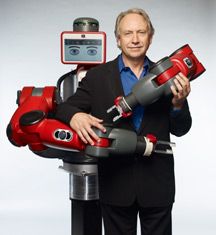Brooks and a robot having a hug
His description of this process is particularly interesting:
Just as there is no central representation there is not even a central system. Each activity producing layer connects perception to action directly. It is only the observer of the Creature who imputes a central representation or central control. The Creature itself has none; it is a collection of competing behaviors. Out of the local chaos of their interactions there emerges, in the eye of an observer, a coherent pattern of behavior. There is no central purposeful locus of control. (1991: 145)It is strikingly similar to Dennett's account of consciousness and cognition under the Multiple Drafts Model (see his 1991). Maybe not so surprising when you consider that both Dennett and Brooks were inspired by Marvin Minsky, but it does lend some theoretical credence to Brooks' work...as well as perhaps some practical clout to Dennett's.
- Brooks, R. 1991. “Intelligence without representation.” Artificial Intelligence, 47: 139-59.
- Dennett, D. 1991. Consciousness Explained. Little, Brown and Company.
